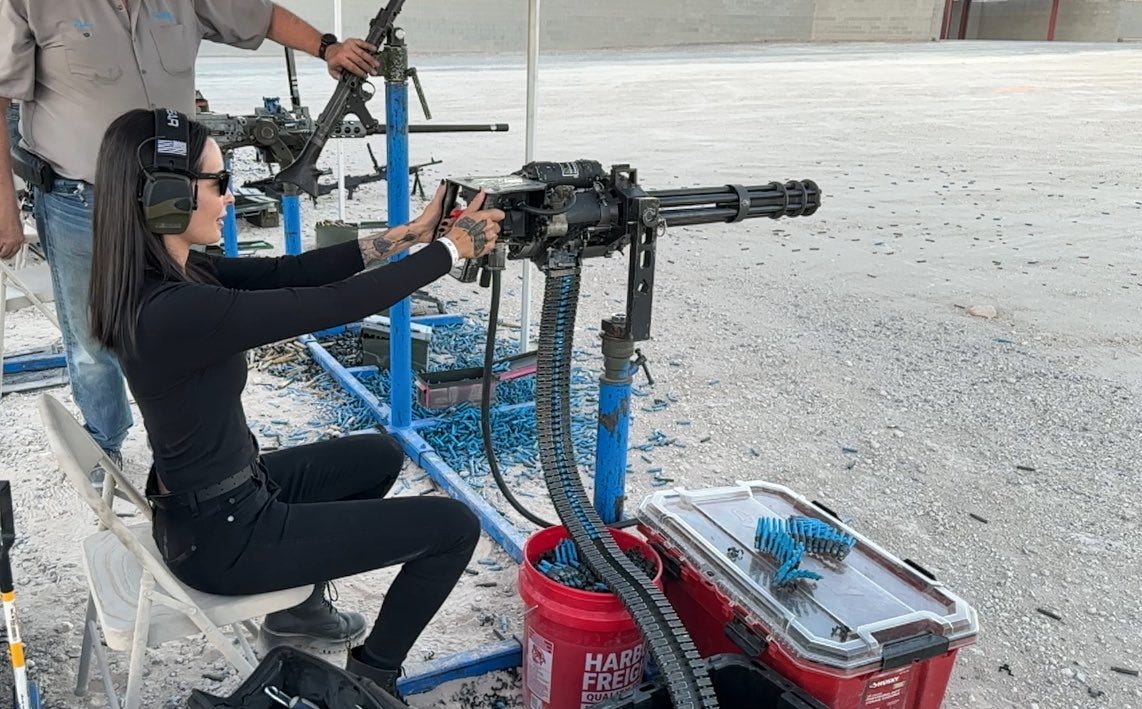Future blindness: why most people only plan for tomorrow
Long-range thinking as a competitive advantage and survival skill
Last week, I had the opportunity to attend Creator Range Day in Las Vegas, which is basically a gathering of YouTube gun creators and military guys. I was one of maybe five people there from X, surrounded by a crowd of (mostly) dudes who’d shown up to shoot some genuinely insane firearms. The energy was exactly what you’d expect when you give people access to military-grade weapons most of them would never get to touch otherwise. Predictably, everyone clustered around the machine guns, the tommy guns, and the minigun (which fires up to 6,000 rounds per minute!)
After a few hours of shooting various guns, I noticed that hardly anyone was using the long-range rifles. There was a full setup for distance shooting with targets placed 558 yards out, and it was almost totally empty. I wandered over partly to take a break from the noise and partly because I was curious about what long-range shooting actually feels like. It ended up being a completely different kind of experience. You settle in behind the rifle, look through the scope, and the target feels almost abstract because of how far away it is. You line up your shot, exhale, lightly pull the trigger, and hear the rifle’s crack, but then there’s a moment of quiet. A second passes, sometimes two, before a faint metallic sound carries back from the distance. That tiny delayed “ding” is the only confirmation that you hit anything at all.
What kept me there longer than I expected was that strange pause between action and outcome. These rifles were bolt-action, so after each shot you manually cycle the next round into the chamber. Everything about it is methodical. You take your shot and you wait, hoping your aim was good but not knowing for certain until that ding returns to you from five football fields away. It requires a different mindset. You slow down. You focus. You go through maybe five rounds in five minutes and each one has a purpose. It isn’t as dramatic as the high-volume guns, but there’s a kind of clarity to it that I found genuinely compelling.
As I stood there between turns, I caught myself thinking about how often this pattern shows up in other parts of life. People naturally gravitate toward whatever offers the strongest immediate sensation, especially when the opportunity is rare or exciting. Very few choose the thing that requires patience, precision, or a willingness to wait for delayed feedback. It wasn’t a metaphor I was trying to craft, it was just an observation that surfaced on its own and has been nagging at me ever since. Because the pattern is everywhere once you see it: immediate impact versus delayed confirmation is one of the defining tensions in how people operate in the world.

We are not built for this.
The human brain evolved to prioritize immediate threats and rewards. If you were a hunter-gatherer on the African savannah fifty thousand years ago, thinking about what might happen five years from now was not a survival-relevant skill. What mattered was whether that rustling in the grass was a predator, whether the fruit in front of you was safe to eat, or whether you could make it back to camp before dark. Our cognitive architecture is optimized for the present tense because for most of human history, that’s all there was.
Psychologists call this temporal myopia, and it’s not a bug in human cognition. The problem is that the world we’ve built requires a completely different kind of thinking, and most people’s brains are still running software designed for an environment that no longer exists. Anything beyond a five-year time horizon feels abstract, unreal, almost fictional. The further out you try to project, the less your brain treats it as something that will actually happen to you. It’s like trying to empathize with a character in a novel. You can do it intellectually, but it doesn’t activate the same neural circuitry as thinking about what you’re going to eat for dinner tonight, or what you’ll wear to that event next week.
Philip Zimbardo and John Boyd spent decades researching what they call time perspective, which is basically a measure of how naturally someone orients toward the past, present, or future. Their work started in the 1990s and culminated in a book called The Time Paradox, where they outlined a set of distinct temporal orientations—some people are more present-focused, some more past-focused, and some naturally lean toward the future.
Most people, they found, default to the present. They make decisions based on immediate circumstances, immediate emotions, immediate incentives.
Only a minority naturally orient toward the future, and those people tend to share certain traits: they’re more likely to feel a sense of internal control over their lives, they’re better at delaying gratification, and they build more stable long-term patterns because they’re not constantly reacting to whatever is happening right now.
But what makes their research especially interesting is, even among people who can think ahead, most of them max out at maybe five to ten years. Anything beyond that starts to feel like science fiction. Behavioral economists have shown repeatedly that people systematically devalue future outcomes the further away they are in time—a phenomenon called temporal discounting. It’s not that we don’t understand intellectually that future consequences matter. It’s that our emotional systems can’t generate the same urgency about something happening in 2045 as they can about something happening next week.
This is why most people can’t sustain long-term projects. It’s why New Year’s resolutions fail by February. It’s why people take on debt they can’t afford, stay in jobs that slowly kill them, avoid confronting problems until they become crises. It’s not a lack of discipline or intelligence. Their brains are doing exactly what they were designed to do, which is to prioritize the present over a future that doesn’t feel real yet.





